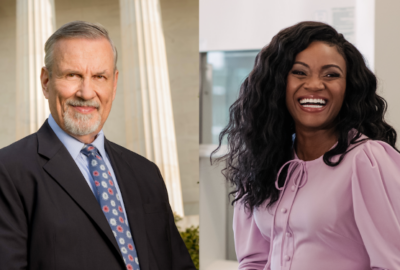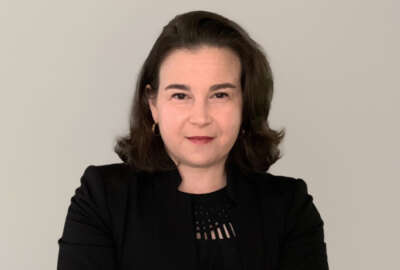Hubbard Radio Washington DC, LLC. All rights reserved. This website is not intended for users located within the European Economic Area.
On Air: Federal News Network
Trending:
Pediatric oncologist’s work on NF1 condition earns Sammies nod
Dr. Brigitte Widemann was able to do something about the terrible disorder known as neurofibromatosis type 1.
Best listening experience is on Chrome, Firefox or Safari. Subscribe to Federal Drive’s daily audio interviews on Apple Podcasts or PodcastOne.
No one likes to see a child in pain from a permanent and inoperable condition. But Dr. Brigitte Widemann was able to do something about the terrible disorder known as neurofibromatosis type 1. She’s the chief of the pediatric oncology branch of the National Cancer Institute and a finalist in this year’s Service to America Medals program. Widemann joined Federal Drive with Tom Temin to explain her work.
Interview transcript:
Tom Temin: Dr. Widemann, good to have you on
Dr. Brigitte Widemann: Thank you so much, Tom. I’m really happy to be on as well, and you did a good job with it. Neurofibromatosis type one, and the abbreviation is NF1. That’s how you mostly refer to it, because it’s pretty complex.
Tom Temin: Sure. And tell us more about the disease itself. What does it do and what’s the history of it?
Dr. Brigitte Widemann: So NF1 is a condition that is inherited, it’s given from parents to children, or it can occur spontaneously, but it is caused by a genetic change in the gene that’s called the NF1 gene. And when this genetic change is present, it’s present in every body cell of a patient, and can cause many different type of manifestations, including tumors that I have focused on developing treatments for called plexiform neurofibromas. These tumors while not cancer tumors can become very debilitating by being disfiguring, by causing pain, by causing impairment and airway function and bowel and bladder function. And one aspect that was really important to me is they develop in ver young children and grow quite relentlessly during early childhood. And NF can cause many other manifestations and problems, but this is the one that I focused to work on to see if we could develop effective treatments to prevent these tumors from growing or possibly shrink them.
Tom Temin: And do we have any idea of how many people a year this type of thing effect?
Dr. Brigitte Widemann: Yes, we do. So about one in 3,000 people have inner neurofibromatosis type one, so it’s not quite that rare. And of the people who have enough fun about up to 50% may have this specific trauma called plexiform neurofibroma. While not all of these tumors become severely debilitating, a subset of these tumors clearly do and usually during early childhood.
Tom Temin: And you developed a methodology for researching this to try to get to what you suspected might be something that could mitigate it. Tell us the methodology there?.
Dr. Brigitte Widemann: So that’s a great question. When you when you look at clinical trials of medicines for patients who have cancers, the cancer tumors typically grow quite quickly. And we can tell within just four to eight to twelve weeks if a medicine is working or not. If we used the same type of measurements that we use in cancer tumors, we would not be able to tell if the medicine is working in NF1, because the tumors consume much more slowly. So we developed a method called volumetric analysis where we measure the tumor volume, and that allows us to tell if tumors grow or shrink much more quickly. And this was really helpful in the clinical trials that I then designed with new medicines to see if they would help my patients.
Tom Temin: And the measurement wasn’t something you could do over a couple of months. This was 10 years of work. Correct?
Dr. Brigitte Widemann: Actually, yeah. So the measurements we started with more than 10 years ago. And now that you raised this, we really learned by using that method, how tumors grow when patients don’t have an effective medicine. And once we actually found an effective medicine, the Food and Drug Administration, which then approved the medicine, they wanted to see data, how it looks in patients that don’t get treatment. And so we have this 10 years worth of data to send to the FDA and they could clearly see yes, this new medicine is different, and changes the natural history of the course of the disease.
Tom Temin: And there was an existing medicine that you suspected might be able to help here, I think was called selumetinib, and it had failed in breast cancer therapy. And so what gave you the clue that it could work in this particular situation for NF1?
Dr. Brigitte Widemann: Yeah,. So we had done a number of clinical trials. One thing that is important in NF1, when it’s mutated, the genetic changes there, it results in upregulation of a pathway called grass pathway, which is mutated in many adult cancers and upregulated in many cancers. So when I saw that there was a medicine being used in cancers, even though it didn’t work in the cancers, I was still hoping that given that this tumor that I’m treating is not a cancer tumor, it might actually work. And we have done a number of trials targeting other components of this pathway, not successfully, so that kind of narrowed it down to this specific drug called selumetinib.
Tom Temin: We are speaking with Dr. Brigitte Widemann, she’s senior investigator and chief of the Pediatric Oncology Branch at the National Cancer Institute, and a finalist in this year’s Service to America Medals program. And there’s an emotional content in dealing with children that are in a really bad way and their families by extension. Any particular cases that stand out for you that you would like to say to yourself, I want to help this kid.
Dr. Brigitte Widemann: Yeah, absolutely. The patients have been so amazing Tom. I have patients who may have been on five or six different clinical trials with no effect any positive effect on shrinking the tumor. Seeing one of these boys who he was nearly 18 when he was started on the selumetinib and his too much rain for the first time. These are indeed emotional and these are victories that we celebrate with our patients. But yes, pain, as you already mentioned early on, is really important, the pain can be debilitating. So having something that can improve pain is hugely helpful. But also reducing disfigurement, and making patients function more. When patients see their clothes fit again, or they can go to a store and buy regular clothes, or when they see their can wrestle with their sibling, something they may not have been able to do before. Those are indeed really happy moments. And we would like to do a lot more for our patients, but it’s progress.
Tom Temin: Alright. And so the progress then is that you found that this drug that was ineffective elsewhere does in fact shrink the tumors to a fair amount.
Dr. Brigitte Widemann: Yes, it shrinks the tumors and also prevents them from growing. And so we did not see complete disappearance of the tumor. As I said, it stops the tumors from growing and shrinks them, which helps the patients and provides clinical benefit. One thing we’re doing now, which I’m very, very excited about, and we hope to start the treatment earlier in younger kids with these tumors before they have become very debilitating, so hopefully we can actually prevent the development of these problems.
Tom Temin: Okay, and we should point out, this is not your only job at the NCI.
Dr. Brigitte Widemann: No I do other things. So one area that I’m very much involved in is applying lessons learned from NF1 to other rare tumors. There are many rare tumors in children and adults where we don’t have effective therapies. So we have an active program for children and adults with rare tumors. And then I’m also serving as the chief of the Pediatric Oncology Branch and oversee a very wonderful group of colleagues, both with basic research interests, translational and clinical research interests. And our goal overall is to make better treatments for kids with cancer,
Tom Temin: And the clinical trials that we’ve described and some of the others that the NCI does, are the patients at NIH itself, or do they do this remotely?
Dr. Brigitte Widemann: For most of the clinical trials that we have, all of the treatment trials the patients come to the NIH, they take their treatment every day at home, but they come in through the NIH to be started. And then we bring them back to NIH to see if the drug works and what the side effects are. With a COVID pandemic, we are loosening up some things and patients can do more things at home. And for some trials, patients can enroll remotely from the home.
Tom Temin: And just briefly, what is your background? What made you choose a research career in oncology and at the NIH of all places?
Dr. Brigitte Widemann: I got my training, I’m from Germany, and I did my pediatric residency training there, and really wanted to go into oncology and then learned that there was a fellowship program at the NIH, something we didn’t have at that time in Germany. And what really intrigued me was the closeness of the bench to the bedside, the ability to do clinical research, and I’ve never regretted coming here. It’s the best place to do clinical research and advanced therapies for kids.
Tom Temin: Dr. Brigitte Widemann is senior investigator and chief of the Pediatric Oncology Branch of the National Cancer Institute. Thanks so much for joining me.
Dr. Brigitte Widemann: Thank you so much for having me. Have a great day.
Copyright © 2024 Federal News Network. All rights reserved. This website is not intended for users located within the European Economic Area.
Tom Temin
Tom Temin is host of the Federal Drive and has been providing insight on federal technology and management issues for more than 30 years.
Follow @tteminWFED





